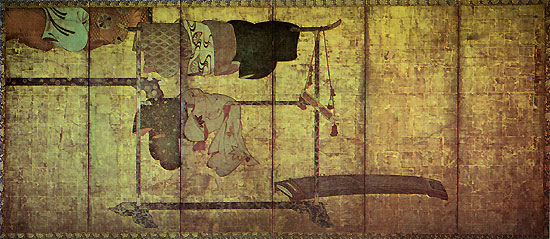| << UbuWeb |
| Aspen no. 10, item 10 |
|
|
| Tagasode |

|
Tagasode (Whose Sleeves?)
Anonymous. Edo period,
Six-fold screen; color on gilded paper; height 67 1/4 in., width, 150 in. From the collection of Mr. and Mrs. Jackson Burke, displayed in the 1971 exhibition of Japanese screens at Asia House, New York City. |
The title of this screen — "Tagasode," meaning "whose sleeves?" — is frequently used for Japanese paintings which hint at the presence of a woman but refrain from actually portraying her. This, it is felt, is more evocative than a literal representation. In this screen, a beautiful woman is suggested by showing her prized possessions — gold-embellished clothes racks laded with beautiful kimono, a tube containing an amulet hung on a silken cord, and a stringed musical instrument, the koto. Everything — from the family emblems on the racks to the tie-dyed designs of the fabrics — clues the viewer to the image of the beautiful owner. (1) |
Again, this reflects the ideal of Zen artists — to express the true life of something, the essense, rather than merely to display what is seen. 1. "Byobu, Japanese Screens from New York Collections," by Miyeko Murase, p. 94, published by The Asia Society, Inc. |
||||
|
© Aspen No. 10, Section 10 |
|
Original format: Single sheet printed both sides, 6 by 13 1/2 inches, folded in half. |
|
|
|
|
|
|
|